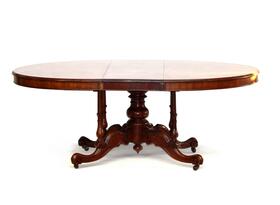Royal Railwayana Right Down the Line
Royal Railwayana Right Down the Line
By Elizabeth Talbot
The mixture of a desirable object, an engaging subject, some history, and a sound provenance, always makes for a strong talking point; add the romance of a local connection and the allure of a royal association and the formula is near-perfect. It does not necessarily equate to a fortune, but it does make for a good story.
On June 30 1967, Wolferton station buildings were auctioned off in three lots, the result of mass closures of railway branch lines. Wolferton was the closest station to Sandringham on the Lyn-Hunstanton line. It was first used by members of the Royal Family in March 1863, a year after they had bought the Sandringham Estate. The then Prince of Wales (later to become King Edward VII) had married Princess Alexandra of Denmark, also in the previous year, and they travelled to the Sandringham Estate by rail after their honeymoon in the Isle of Wight.
This was the start of a long association with the station by the Royal Family and many distinguished visitors to Sandringham. In 1876, the station was extended by the construction of a suite of Royal waiting rooms. The work was carried out by Bennett of Downham, who submitted a tender of £1,226 for the work.
Just over 20 years later, when the line between Lyn and Wolferton was doubled, the station was further extended to include a new suite of Royal rooms on the down side of the line. The waiting rooms were used to entertain shooting parties at Sandringham for lunch until February 1967.
On Friday 19 May 1967, Ingram Watson & Son, chartered surveyors and auctioneers in Hunstanton, held a public auction in the town-hall of “furniture etc., including that in the former Royal Retiring Rooms at Wolferton Station”. The multi-hundred lot sale was comprised of various vendors’ consignments, but also included 30 from public and staff rooms at Wolferton Station and just 18 from the Royal Suite. The sale attracted much local press attention, and many newspapers carried accounts of the day, accompanied by a varied selection of photographs.
The auctioneer was Mr John Storey and about 300 people attended the auction. The 18 lots, which included fireside settees, salon chairs, a couch and armchair, a cheval mirror, an Axminster carpet, fire tools and various pictures, realised a total hammer price of £386 11s., which is a total of about £9,000 in today’s money. There was general acknowledgement on the day that bidding was not brisk and that prices were disappointing.
The headlining lot was no. 209, described in the catalogue as “A handsome mahogany framed dining table on pedestal legs with removable centre leaf, extending to 6ft 6ins”, which sold for £125. The press reported, “It was bought by Mr John Turrell, a retired farmer, of Wiggenhall St. Mary. He said he had set a figure of £100 for it but would have gone more than the £125 if necessary. He had recently moved into a new bungalow and his present dining table needed replacing.” Roll forward 56 years and the table has been consigned to auction for a second time, having remained in the same family ever since. The current vendor who inherited it from her father, is now downsizing and has entered the table into the next Railwayana auction to be held at Diss Auction Rooms on February 14.
TW Gaze Railway specialist and manager of the sale, Dan Woods, is very excited. “This piece of furniture is special because of its origins, its history and its use”, he enthuses. “It is a lovely quality Victorian table which still bears the original maker’s label, ‘Blyth & Sons, Manufacturers, Chiswell, London’. Blyth & Sons were British and Irish furniture makers which flourished 1820 – 1888. They were high calibre specialists who won many prestigious commissions from notable institutions and establishments throughout the world, and certainly they provided quality furnishings for railway companies throughout the British Isles.”

Mr Woods continues, “The fact the table has remained in private hands since the original auction and has passed to descendants within the same family is tremendous. What’s more, it was such a treasured purchase and so well looked after that is has survived into the 21st Century in wonderful condition. The table will be sold with access to a copy of the original auction catalogue and various newspaper-cuttings of the event, so its provenance travels with it.”
The table joins nearly 200 lots of other impressive railway history, including enamelled platform signs, railwaymen’s accessories, trackside artefacts and train parts. Despite its gilt-edged origins, the table carries a very accessible estimate. Mr Woods explains, “We have to be realistic within the context of the current market for antique ‘brown furniture’. Consequently, my valuation is £300 – 500, and my hope is that the table will be bought by another true enthusiast who fully appreciates the bigger picture. If it found its way back into a refurbished station building, then that would be the ultimate happy ending.”
Fully illustrated catalogues available at twgaze.co.uk. Railwayana valuations and specialist sale advice from d.woods@twgaze.co.uk.

